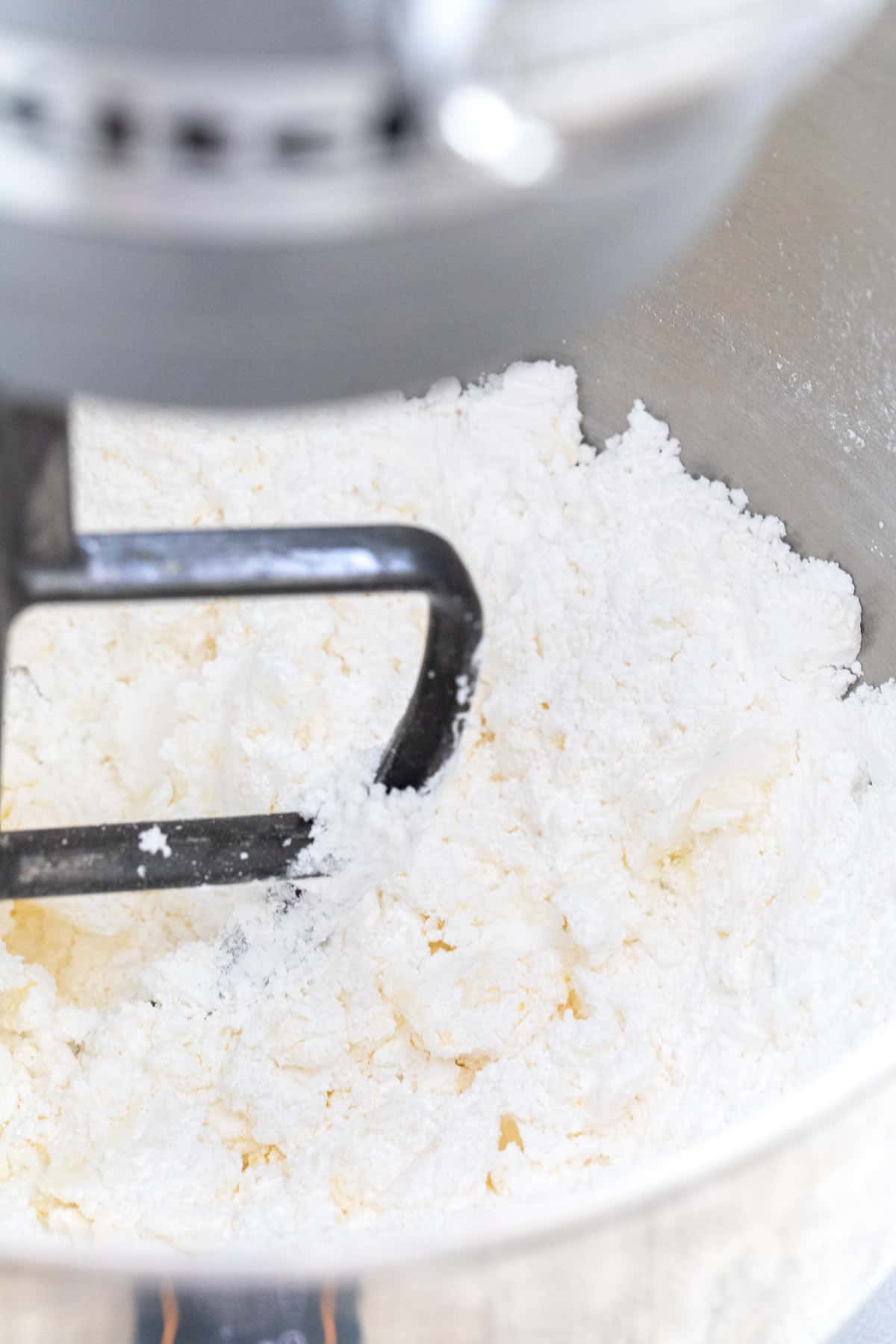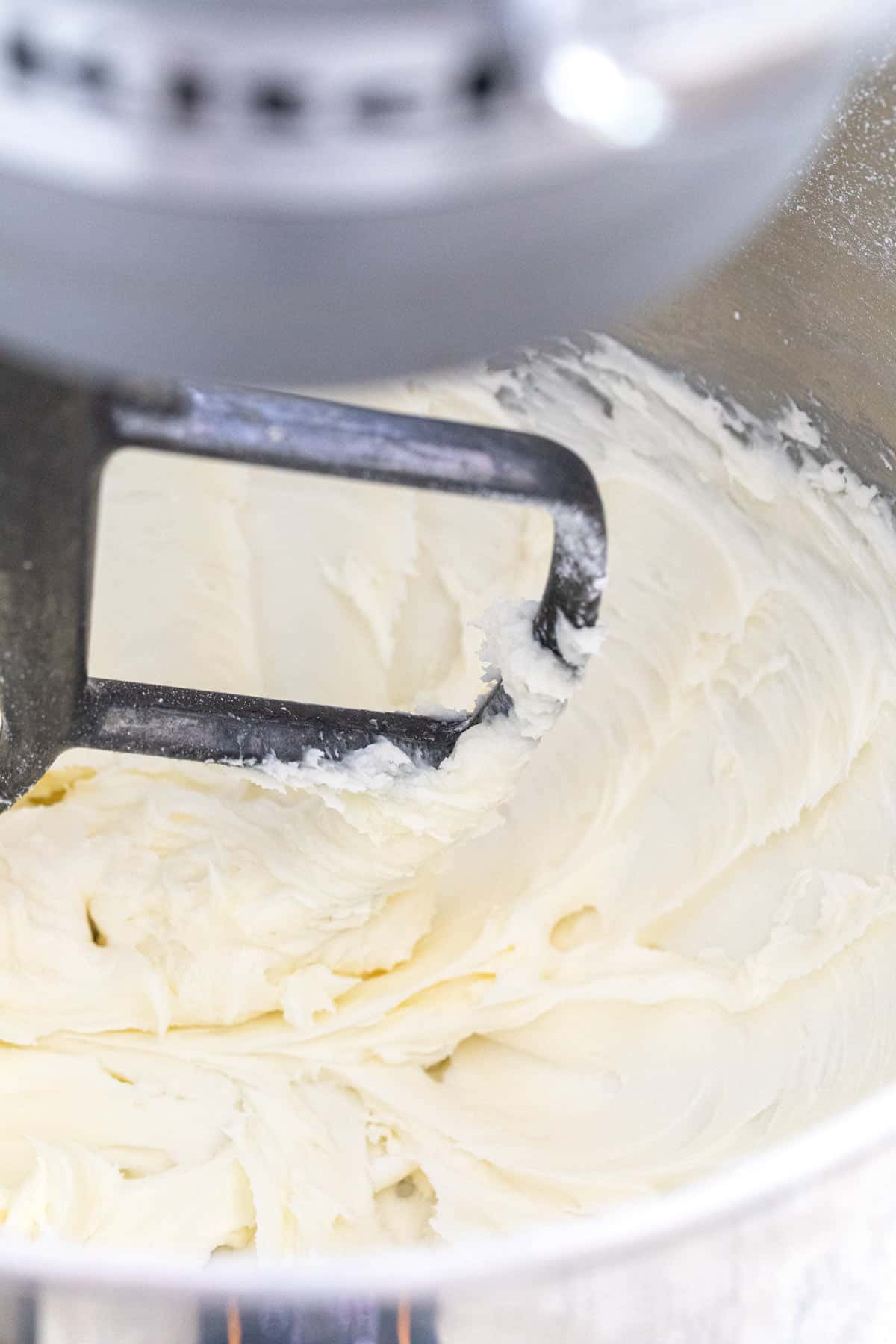Learn how to make cream cheese frosting from scratch with just a handful of simple ingredients. Use it as the finishing touch to pipe on your favorite cake or cupcake or even spread it onto cookies.

Recipe Science
- The high-fat content in cream cheese helps create a smooth, creamy texture in the frosting, providing stability and richness.
- Mixing cream cheese with powdered sugar creates a thick, spreadable consistency because the fine sugar particles absorb moisture and help firm up the frosting.
- The slight acidity of cream cheese balances the sweetness of the sugar, giving the frosting a tangy flavor that complements a variety of baked goods.
Jump To a Section
Why It Works
This homemade cream cheese frosting recipe is a versatile topping for any baked good. The creamy and tangy dairy base provides a nice balance to the sweet frosting. The recipe consists of only four everyday kitchen staples, but their temperature is vital to a smooth texture.
Cream cheese and butter are dense ingredients. Softening them at room temperature makes them much easier to aerate and use for decorating. Once they reach that point, it only takes a few minutes to whip together. Spread it to make a frosted cake, individual cupcakes, or frosting cookies.
Ingredients You’ll Need

- Cream Cheese: Adds a tangy flavor and rich texture. Only use blocks of cream cheese for the best texture.
- Butter: Use unsalted butter for the recipe. When whipped, the butterfat traps the air to create a smooth and creamy frosting consistency.
- Powdered Sugar: The fine particles make for a very smooth consistency while incorporating easily with the butter and cream cheese. The small amount of cornstarch creates a stiffer texture, making it easier to hold its shape when piped for cakes or cupcakes.
- Vanilla: Enhances the sweet taste and adds dimension to the frosting.
See the recipe card below for all ingredients and measurements (US and metric).
Ingredient Substitutions
Now that you know how to make the best cream cheese frosting, it’s easy to customize! Try these fun and delicious variations:
- Chocolate: Add ¼ to ½ cup of Dutch-processed cocoa powder when adding the powdered sugar to make a chocolate cream cheese frosting.
- Nutella: Add ¼ cup of Nutella after adding in the cream cheese. Adjust the level, adding 1 tablespoon more at a time.
- Nut Butter: Add ¼ cup of peanut butter or almond butter as the last ingredient. Add more in 1-tablespoon increments until the desired flavor is reached.
- Fruit: Process freeze-dried strawberries, raspberries, or blueberries in a blender or food processor until it forms a powder. Add ¼ to ½ cup of powder to the powdered sugar.
How to Make Cream Cheese Frosting
Step 1: Soften the Butter and Cheese
Before mixing the butter and cream cheese, remove them from the refrigerator and let them sit on the counter. It’s vital to soften butter and cheese to just below room temperature, about 65ºF (18ºC).
For the butter, this ensures that the needle-like beta prime fat crystals hold their shape. For the cream cheese, it makes it easier to incorporate and prevents a lumpy frosting.

Step 2: Cream the Butter
Mix the softened butter and powdered sugar first to create air pockets in the butter and trap them inside to aerate the mixture. This process is called creaming.

After mixing, it should look fluffy. I also use a similar technique to make fluffy buttercream frosting.
Tips for Perfect Execution: If the powdered sugar is very clumpy, sift it before using it. You may notice that some cornstarch is used in powdered sugar. This type of sugar has a high surface area that likes to pick up moisture, so it needs some starch to prevent clumping and caking during storage. The starch also helps the frosting hold its shape.

Step 3: Gradually add Cream Cheese
Add the cheese in two additions, ensuring it gets fully incorporated into the frosting without large lumps. It also prevents the dense ingredients from deflating too much air from the creamed butter mixture. Gradually incorporating keeps the mixture smooth, light, and pipeable/spreadable. Add more powdered sugar, one tablespoon at a time, for a stiffer and sweeter frosting.
Mixing the sugar, butter, and cheese together simultaneously will yield a denser frosting, ideal for a pumpkin cake but not for cupcakes or cookies.

Step 4: Add Vanilla Flavor
Add the vanilla extract at the very end so that the small amount of moisture doesn’t prevent the frosting from becoming aerated.

Step 5: Refrigerate the Frosting
Right after whipping in my electric mixer, I like to chill the frosting briefly. Heat is generated during mixing, causing it to rise a few degrees in temperature. Refrigerating until it reaches 60 to 65ºF (15 to 18ºC) helps it stiffen slightly and hold its shape better for decorating.

Step 6: Using and Storing
Cream cheese frosting is great for spreading on a layered cake, red velvet cake, and carrot cake.

It also works well to add it to a pastry bag and pipe designs onto cookies and cupcakes.
If you are not using the frosting immediately, cover and chill it, then let it return to this temperature range. The recipe contains dairy, so it must be refrigerated within 2 hours of being at room temperature. Keep this in mind after assembling your desserts.
Frequently Asked Questions
Yes, use bricks rather than the spreadable varieties sold in plastic containers. The latter already has air whipped in, making it light and airy. Full-fat cream cheese bricks are denser, hold the air pockets better, and keep their structure when decorating. Reduced-fat products contain extra gums like xanthan and guar to create a similar mouthfeel, but the flavor is slightly different.
Yes! It contains fresh dairy, so it should be refrigerated within two hours of being at room temperature. Keep this in mind when serving. Assemble the dessert, then refrigerate if you are not eating right away.
Cream cheese frosting freezes very well! Transfer to a resealable freezer bag, pressing out the air. Freeze for up to 1 month. Defrost to 60 to 65ºF (15 to 18ºC). The frosting can be whisked for a few seconds to make it fluffy.
Icing has a thinner consistency, similar to a sugar cookie icing. It drizzles on top of coffee cakes, bundt cakes, or cinnamon rolls. Frosting is thicker, with a smooth and fluffy texture. It’s better for piping on top cakes, cupcakes, fruit pizzas, or cookies.
Powdered sugar has finely ground granules that give a smooth texture in frostings and glazes. It instantly incorporates the frosting ingredients and doesn’t leave a gritty texture. Granulated sugar has tiny, round crystals, which require heat and moisture to dissolve.
Ways to Use It
If you tried this Cream Cheese Frosting recipe, please leave a 🌟 star rating and let me know how it went in the 📝 comments below!
Cream Cheese Frosting

Ingredients
- ½ cup unsalted butter, softened to 65ºF (18ºC)
- 2 cups powdered sugar
- 8 ounces cream cheese, softened to 65ºF (18ºC)
- ½ teaspoon pure vanilla extract
Instructions
- Soften the Ingredients – Before mixing the butter and cream cheese, remove them from the refrigerator and let them sit on the counter. It’s vital to soften them to just below room temperature, about 65ºF (18ºC).
- Cream the Butter – In a stand mixer fitted with a paddle attachment or hand mixer, beat softened butter and powdered sugar on low speed until just incorporated, about 30 seconds. Gradually increase the speed to medium, beating the mixture until light and fluffy, about 1 minute.
- Incorporate the Cream Cheese – Add half of the softened cream cheese and beat on medium speed until incorporated, about 15 seconds. Add the remainder of the cream cheese and beat until smooth and fluffy, about 15 seconds.
- Add the Vanilla – Add the vanilla extract, and beat until combined, about 10 to 15 seconds.
- Chill the Frosting – The frosting can be used immediately. However, if needed, cover and refrigerate until it slightly stiffens up and feels cool to the touch before using it for decorating, around 60 to 65ºF (15 to 18ºC).
- Storing – If not using the frosting immediately, store it in an airtight container. Press and cover the exposed areas with plastic wrap. Before using, place it on the counter until it reaches 60 to 65ºF (15 to 18ºC). Spread or pipe onto baked goods as desired.
Recipe Video

Notes
- Recipe Yield: 1 ¾ cup
- Serving Size: 2 tablespoons
- Storing: Store in an airtight container for up to 5 days. Press and cover the exposed areas with plastic wrap.
- Freezing: Freeze in a resealable plastic bag for up to 1 month. Defrost to 60 to 65ºF (15 to 18ºC). If needed, whisk for a few seconds in a stand mixer to make it light and airy.
Nutrition Facts
Percent Daily Values are based on a 2000-calorie diet. All nutritional information is based on estimated third-party calculations. Each recipe and nutritional value will vary depending on the brands you use, measuring methods, and portion sizes per household.









Leave a Comment